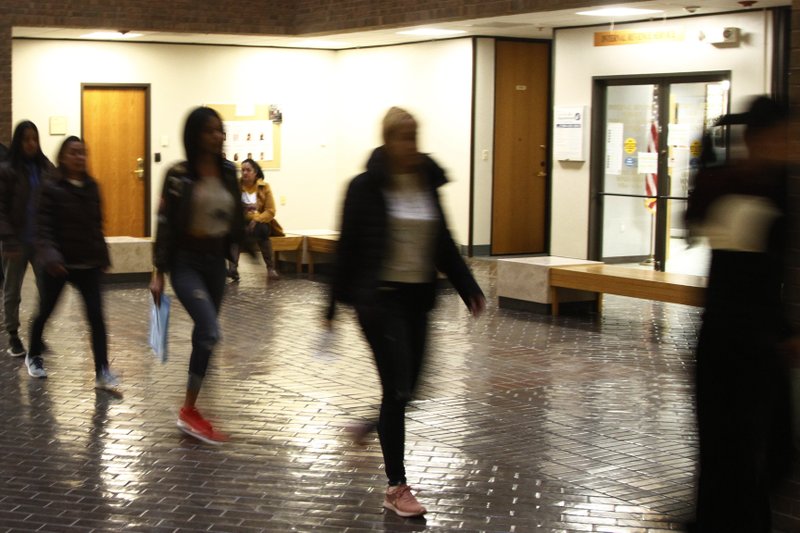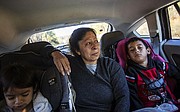LUMPKIN, Ga. -- In a locked, guarded courtroom in a compound surrounded by razor wire, Immigration Judge Jerome Rothschild waits -- and stalls.
A Spanish interpreter is running late because of a flat tire. Rothschild tells the five immigrants before him that he'll take a break before the proceedings even start.
"We are, untypically, without an interpreter," Rothschild tells a lawyer who enters the courtroom at the Stewart Detention Center after driving down from Atlanta, about 140 miles away.
In its disorder, this is, in fact, a typical day in the crowded U.S. immigration court system of which Rothschild's courtroom is just one small outpost.
A surge in the arrival of asylum-seekers and the crackdown on the Southwest border and illegal immigration have pushed more people into deportation proceedings, swelling the court's docket to 1 million cases.
"It is just a cumbersome, huge system, and yet administration upon administration comes in here and tries to use the system for their own purposes," says Immigration Judge Amiena Khan in New York City, speaking in her role as vice president of the National Association of Immigration Judges.
[Video not showing up above? Click here to watch » https://www.youtube.com/watch?v=LIMrqDjrEWg]
"And in every instance, the system doesn't change on a dime, because you can't turn the Titanic around."
The Associated Press visited immigration courts in 11 different cities more than two dozen times during a 10-day period in late fall. In courts from Boston to San Diego, reporters observed scores of hearings that illustrated how crushing caseloads and shifting policies have landed the courts in unprecedented turmoil:
• Chasing efficiency, immigration judges double- and triple-book hearings that can't possibly be completed, leading to numerous cancellations. Immigrants get new court dates, but not for years.
• Young children are everywhere and sit on the floor or stand or cry in cramped courtrooms. Many immigrants don't know how to fill out forms, get records translated or present a case.
• Frequent changes in the law and rules for how judges manage their dockets make it impossible to know what the future holds when immigrants finally have their day in court. Paper files are often misplaced, and interpreters are often missing.
In a federal building in downtown Manhattan, the docket lists stretch to a second page outside the immigration courtrooms. Crowds of people wait in the hallways for their turn to see a judge.
When judges assign future court dates, immigrants are asked to come back in February or March -- of 2023.
On average, cases on the country's immigration docket have been churning through the courts for nearly two years. Many immigrants have been waiting much longer, especially those who aren't held in detention facilities.
In Boston, Audencio Lopez applied for asylum seven years ago. The 39-year-old left a Guatemalan farming town to cross the border illegally as a teenager in 1997 and soon found a job at a landscaping company where he still works, maintaining the grounds at area schools.
But it was just this past November that he headed to the imposing Boston courthouse to learn his fate.
After about an hour of questioning, Judge Lincoln Jalelian tells Lopez he'll take the case under advisement. The government attorney says she won't oppose granting Lopez a visa because of his "exemplary" record and community service, which means he'll likely be able to stay.
Many children have immigration cases of their own. They sit on wooden benches with their parents, grandparents or foster families.
There are also American-born children tagging along with immigrant parents the government seeks to deport.
Veronica Mejia left El Salvador as a young teen and has now lived a third of her life in the United States.
Now 20, Mejia raises her right hand and vows to tell the truth. She has a job in a California warehouse, a boyfriend and an 8-month-old daughter.
Immigration Judge Ashley Tabaddor breaks the news to Mejia: She doesn't qualify for asylum under the law and issues an order for her to return to El Salvador.
On Tabaddor's computer, there are eight color-coded dashboards showing how close she is to meeting goals set by the Department of Justice for the country's 440 immigration judges. Like many, she's nowhere near completing the annual case completion target, and her dashboard is a deep red.
Officials at the Department's Executive Office for Immigration Review are adding interpreters in Spanish and Mandarin, judges and clerks. They've started special centers to handle video hearings for immigrants on the U.S.-Mexico border.
They're also moving to an electronic system to try to put an end to the heaps of paper files hoisted in and out of courtrooms.
The entire effort is a quest for efficiency, though director James McHenry acknowledges "we're still getting outpaced" by new cases.
Information for this article was contributed by Philip Marcelo, Sophia Tareen, Noreen Nasir, Cedar Attanasio, Nomaan Merchant, Adriana Gomez Licon, Astrid Galvan, Brady McCombs, Elliot Spagat and Colleen Long of The Associated Press.
A Section on 01/17/2020


